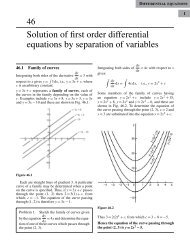trigonometry
Create successful ePaper yourself
Turn your PDF publications into a flip-book with our unique Google optimized e-Paper software.
142 GEOMETRY AND TRIGONOMETRY<br />
Problem 13. Sketch the circle given by the<br />
equation: x 2 + y 2 − 4x + 6y − 3 = 0.<br />
The equation of a circle, centre (a, b), radius r is<br />
given by:<br />
(x − a) 2 + (y − b) 2 = r 2<br />
The general equation of a circle is<br />
x 2 + y 2 + 2ex + 2fy + c = 0.<br />
From above a =− 2e<br />
2 , b =−2f 2 and<br />
r = √ (a 2 + b 2 − c).<br />
Hence if x 2 + y 2 − 4x + 6y − 3 = 0<br />
then<br />
and<br />
a =− ( ) (<br />
−4<br />
2<br />
= 2, b =−<br />
62<br />
)<br />
=−3<br />
r = √ [(2) 2 + (−3) 2 − (−3)]<br />
= √ 16 = 4<br />
Thus the circle has centre (2, −3) and radius 4,as<br />
shown in Fig. 14.11.<br />
Alternatively, x 2 + y 2 − 4x + 6y − 3 = 0 may be<br />
rearranged as:<br />
(x − 2) 2 + (y + 3) 2 − 3 − 13 = 0<br />
i.e. (x − 2) 2 + (y + 3) 2 = 4 2<br />
which represents a circle, centre (2, −3) and<br />
radius 4, as stated above.<br />
y<br />
4<br />
Now try the following exercise.<br />
Exercise 66 Further problems on the equation<br />
of a circle<br />
1. Determine the radius and the co-ordinates of<br />
the centre of the circle given by the equation<br />
x 2 + y 2 + 6x − 2y − 26 = 0.<br />
[6, (−3, 1)]<br />
2. Sketch the circle given by the equation<br />
x 2 + y 2 − 6x + 4y − 3 = 0.<br />
[Centre at (3, −2), radius 4]<br />
3. Sketch the curve x 2 + (y − 1) 2 − 25 = 0.<br />
[Circle, centre (0, 1), radius 5]<br />
4. Sketch the curve x = 6√ [1<br />
− (y/6)<br />
2 ] .<br />
[Circle, centre (0, 0), radius 6]<br />
14.6 Linear and angular velocity<br />
Linear velocity<br />
Linear velocity v is defined as the rate of change<br />
of linear displacement s with respect to time t. For<br />
motion in a straight line:<br />
change of displacement<br />
linear velocity =<br />
change of time<br />
i.e.<br />
v = s t<br />
(1)<br />
The unit of linear velocity is metres per second (m/s).<br />
−4<br />
−2<br />
2<br />
0<br />
−2<br />
−3<br />
−4<br />
2<br />
r = 4<br />
4<br />
6 x<br />
Angular velocity<br />
The speed of revolution of a wheel or a shaft is<br />
usually measured in revolutions per minute or revolutions<br />
per second but these units do not form part<br />
of a coherent system of units. The basis in SI units<br />
is the angle turned through in one second.<br />
Angular velocity is defined as the rate of change of<br />
angular displacement θ, with respect to time t. For an<br />
object rotating about a fixed axis at a constant speed:<br />
−8<br />
angular velocity =<br />
angle turned through<br />
time taken<br />
Figure 14.11<br />
i.e.<br />
ω = θ t<br />
(2)










